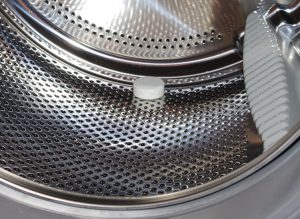1. Washing Machine Sanitization Strategies
There are a number of washing machine sanitization strategies. If you have a front loading washing machine, the rubber door seal can trap a lot of water that can promote mold growth. After every wash, wipe the rubber gasket with a clean, dry cloth to remove residual water deposits. Remember, a damp environment is an ideal breeding ground for mold growth so leave your washing machine door open a little, and this will help it to stay dry.
You should never leave a wet wash in your machine any longer than necessary and be careful how much detergent you use when washing. Using excessive amounts can lead to a buildup of soap scum. If you use liquid detergents and fabric softeners they can cause a buildup of sticky wax in your washing machines drum. This problem is more serious when you wash clothes at lower temperatures. Using powdered detergents and a half cup of distilled white vinegar as a fabric softener is a good alternative.
2. Cleaning a Top Loader Washing Machine
Many sources will recommend that you use bleach for cleaning your washing machine. Bleach is very effective, but many people prefer not to use it, and it can be hard on your septic system. As an alternative, baking soda and white vinegar can be used to clean your washing machine. The vinegar will act as a disinfectant, killing mold spores and helping to remove unpleasant odors. White vinegar will also dissolve soap and lime deposits because of its acidity. The baking soda will act as a powerful cleaning agent and act as a deodorizer. Follow these four steps to clean your machine using this method every alternate month for the best results.
- Set your washer to hot water on the largest load setting and don’t add any detergent or clothes. Run the machine, then add 1 quart of white vinegar and let the water agitate for a minute until it’s mixed.
- Add ½ cup of baking soda, allow a few minutes for the baking soda to mix into the water and then leave it to sit in the machine for an hour.
- While the drum is soaking in the cleaning mixture, you can work on the rest of the machine and give it a good overall cleaning.
- Finish off the wash cycle, allow the water to run out and if possible spin the machine while draining. If this isn’t possible, finish off by running a plain hot water cycle to rinse away any remaining white vinegar and baking soda deposits.
3. Cleaning a Front Loader Washing Machine
To clean your front loading washer all you will need is some white vinegar and to follow these three easy steps.
Run a long wash cycle using water and a cup of white vinegar, with no clothes loaded.
Wash the machine down with a soft, clean cloth, using a 50/50 water and white vinegar cleaning solution. Pay particular attention to the seals, door gasket, and door interior.
Rinse the seals and door gasket with clean water the prevent deterioration and then leave the door ajar to allow the machine to air out.
Reliable Washing Machine Repair Services
The modern home isn’t complete without a well functioning washing machine. For the best repair results, you should consider assistance from a professional home appliance repair service.
For further assistance or advice with your washing machine repair needs, be sure to speak to a certified appliance repair specialist today.
